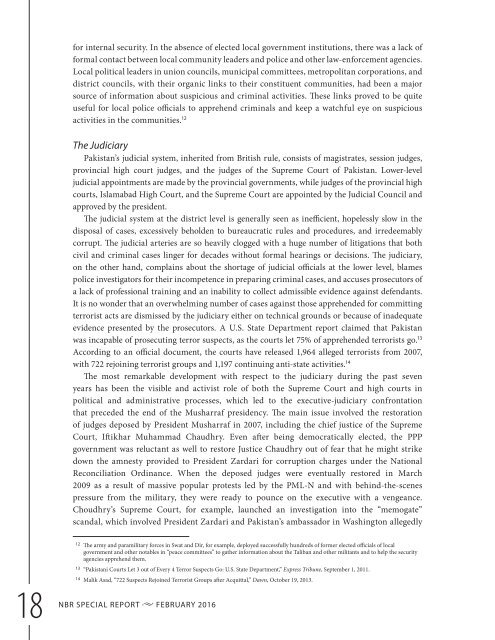pakistan’s
SR55_Mapping_Pakistan_February2016
SR55_Mapping_Pakistan_February2016
Create successful ePaper yourself
Turn your PDF publications into a flip-book with our unique Google optimized e-Paper software.
for internal security. In the absence of elected local government institutions, there was a lack of<br />
formal contact between local community leaders and police and other law-enforcement agencies.<br />
Local political leaders in union councils, municipal committees, metropolitan corporations, and<br />
district councils, with their organic links to their constituent communities, had been a major<br />
source of information about suspicious and criminal activities. These links proved to be quite<br />
useful for local police officials to apprehend criminals and keep a watchful eye on suspicious<br />
activities in the communities. 12<br />
The Judiciary<br />
Pakistan’s judicial system, inherited from British rule, consists of magistrates, session judges,<br />
provincial high court judges, and the judges of the Supreme Court of Pakistan. Lower-level<br />
judicial appointments are made by the provincial governments, while judges of the provincial high<br />
courts, Islamabad High Court, and the Supreme Court are appointed by the Judicial Council and<br />
approved by the president.<br />
The judicial system at the district level is generally seen as inefficient, hopelessly slow in the<br />
disposal of cases, excessively beholden to bureaucratic rules and procedures, and irredeemably<br />
corrupt. The judicial arteries are so heavily clogged with a huge number of litigations that both<br />
civil and criminal cases linger for decades without formal hearings or decisions. The judiciary,<br />
on the other hand, complains about the shortage of judicial officials at the lower level, blames<br />
police investigators for their incompetence in preparing criminal cases, and accuses prosecutors of<br />
a lack of professional training and an inability to collect admissible evidence against defendants.<br />
It is no wonder that an overwhelming number of cases against those apprehended for committing<br />
terrorist acts are dismissed by the judiciary either on technical grounds or because of inadequate<br />
evidence presented by the prosecutors. A U.S. State Department report claimed that Pakistan<br />
was incapable of prosecuting terror suspects, as the courts let 75% of apprehended terrorists go. 13<br />
According to an official document, the courts have released 1,964 alleged terrorists from 2007,<br />
with 722 rejoining terrorist groups and 1,197 continuing anti-state activities. 14<br />
The most remarkable development with respect to the judiciary during the past seven<br />
years has been the visible and activist role of both the Supreme Court and high courts in<br />
political and administrative processes, which led to the executive-judiciary confrontation<br />
that preceded the end of the Musharraf presidency. The main issue involved the restoration<br />
of judges deposed by President Musharraf in 2007, including the chief justice of the Supreme<br />
Court, Itikhar Muhammad Chaudhry. Even ater being democratically elected, the PPP<br />
government was reluctant as well to restore Justice Chaudhry out of fear that he might strike<br />
down the amnesty provided to President Zardari for corruption charges under the National<br />
Reconciliation Ordinance. When the deposed judges were eventually restored in March<br />
2009 as a result of massive popular protests led by the PML-N and with behind-the-scenes<br />
pressure from the military, they were ready to pounce on the executive with a vengeance.<br />
Choudhry’s Supreme Court, for example, launched an investigation into the “memogate”<br />
scandal, which involved President Zardari and Pakistan’s ambassador in Washington allegedly<br />
12 The army and paramilitary forces in Swat and Dir, for example, deployed successfully hundreds of former elected officials of local<br />
government and other notables in “peace committees” to gather information about the Taliban and other militants and to help the security<br />
agencies apprehend them.<br />
13 “Pakistani Courts Let 3 out of Every 4 Terror Suspects Go: U.S. State Department,” Express Tribune, September 1, 2011.<br />
18<br />
NBR<br />
14 Malik Asad, “722 Suspects Rejoined Terrorist Groups ater Acquittal,” Dawn, October 19, 2013.<br />
SPECIAL REPORT u FEBRUARY 2016



